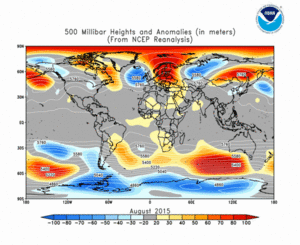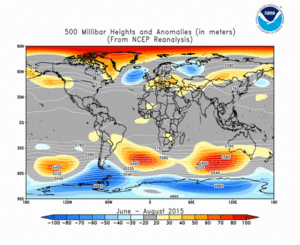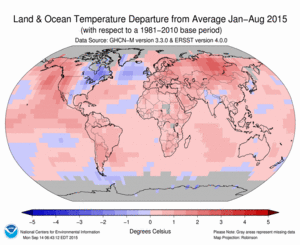Note: With this report and data release, the National Centers for Environmental Information is transitioning to improved versions of its global land (GHCN-M version 3.3.0) and ocean (ERSST version 4.0.0) datasets. Please note that anomalies and ranks reflect the historical record according to these updated versions. Historical months and years may differ from what was reported in previous reports. For more, please visit the associated FAQ and supplemental information.
Introduction
Temperature anomalies and percentiles are shown on the gridded maps below. The anomaly map on the left is a product of a merged land surface temperature (Global Historical Climatology Network, GHCN) and sea surface temperature (ERSST.v4) anomaly analysis as described in Huang et al. (2015). Temperature anomalies for land and ocean are analyzed separately and then merged to form the global analysis. For more information, please visit NCDC's Global Surface Temperature Anomalies page. The percentile map on the right provides additional information by placing the temperature anomaly observed for a specific place and time period into historical perspective, showing how the most current month, season or year compares with the past.
The most current data August be accessed via the Global Surface Temperature Anomalies page.
Temperatures
In the atmosphere, 500-millibar height pressure anomalies correlate well with temperatures at the Earth's surface. The average position of the upper-level ridges of high pressure and troughs of low pressure—depicted by positive and negative 500-millibar height anomalies on the  August 2015 and
August 2015 and  June–August 2015 maps—is generally reflected by areas of positive and negative temperature anomalies at the surface, respectively.
June–August 2015 maps—is generally reflected by areas of positive and negative temperature anomalies at the surface, respectively.
August
The combined average temperature over global land and ocean surfaces for August 2015 was 0.88°C (1.58°F) above the 20th century average of 15.6°C (60.1°F) and the highest August in the 136-year record. This value surpassed the previous record set in 2014 by 0.09°C (0.16°F). Most of the world's surface was substantially warmer than average and, in some locations, record warm during August 2015, contributing to the monthly global record warmth. This was the sixth month in 2015 that has broken its monthly temperature record (February, March, May, June, July, and August). August 2015 tied with January 2007 as the third warmest monthly departure from average for any of the 1628 months since records began in January 1880, behind February 2015 and March 2015 (+0.89°C / +1.60°F). Five of the ten largest monthly temperature departures from average occurred in 2015.
The average global land surface temperature for August 2015 was 1.14°C (2.05°F) above the 20th century average—the highest August value in the 1880–2015 record, exceeding the previous record set in 1998 by +0.13°C (+0.23°F). According to the Land and Ocean Temperature Percentiles map (shown above), much-warmer-than-average conditions was present across much of the western contiguous U.S., Mexico, South America, Africa, Europe, and parts of eastern Asia. According to the Land & Ocean Temperature Percentiles map, record warmth was observed across South America and parts of Europe, Asia, and Africa. South America, Europe, and Africa experienced their warmest August average temperature since 1910. Near- to much-cooler-than-average conditions were present across Alaska, western Canada, the central contiguous U.S., and western and southeastern Asia.
Select national information is highlighted below. (Please note that different countries report anomalies with respect to different base periods. The information provided here is based directly upon these data):
- The August 2015 temperature departure for Germany was 2.8°C (5.0°F) above the 1981–2010 average—resulting in the second warmest August since 1901, according to Germany's Met Service (Deutscher Wetterdienst).
- Much warmer-than-average conditions dominated across much of Argentina during August 2015, with many locations experiencing record temperatures—according to Argentina's Met Service (Servicio Meteorológico Nacional de Argentina). Some locations recorded temperatures as high as 40°C (104°F).
- According to the UK Met Office, the United Kingdom experienced cooler-than-average conditions during August 2015, resulting in a national mean temperature of 14.7°C (58.5°F), which is 0.2°C (0.36°F) below the 1981–2010 average.
- Spain experienced a warmer-than-average August, with an average temperature of 24.5°C (76.1°F)—which is 0.5°C (0.9°F) above the 1981–2010 average.
- The average temperature for Denmark for August 2015 was 17.4°C (63.3°F), which is 1.7°C (3.1°F) above the 1961–1990 average and the warmest August since 2009, according to Denmark's Met Service (DMI).
- Australia, as a whole, had a warmer-than-average August at 0.61°C (1.10°F) above the 1961–1990 average. However, Tasmania had below-average conditions, resulting in the third lowest temperature departure (-1.27°C / -2.29°F) since national records began in 1910, according to Australia's Bureau of Meteorology.
Across the oceans, the August 2015 globally-averaged sea surface temperature was 0.78°C (1.40°F) above the 20th century average—the highest temperature for any month in the 1880–2015 record and surpassing the previous record set in July 2015 by 0.04° (0.07°F). According to the Land & Ocean Percentiles map, large portions of the seven seas (where temperature records are available) recorded much-warmer-than-average temperatures, with much of the eastern and equatorial Pacific Ocean, Indian Ocean, and parts of the Atlantic experiencing record warmth.
El Niño conditions were present across the equatorial Pacific Ocean during August 2015. According to analysis by NOAA's Climate Prediction Center, sea surface temperatures during August were near or greater than 2°C (3.6°F) above the 1981–2010 average in the eastern half of the equatorial Pacific Ocean. There is a greater than 90 percent chance that El Niño will continue through Northern Hemisphere winter 2015/16.
| August | Anomaly | Rank (out of 136 years) | Records | ||||
|---|---|---|---|---|---|---|---|
| °C | °F | Year(s) | °C | °F | |||
| Global | |||||||
| Land | +1.14 ± 0.21 | +2.05 ± 0.38 | Warmest | 1st | 2015 | +1.14 | +2.05 |
| Coolest | 136th | 1912 | -0.74 | -1.33 | |||
| Ocean | +0.78 ± 0.04 | +1.40 ± 0.07 | Warmest | 1st | 2015 | +0.78 | +1.40 |
| Coolest | 136th | 1908 | -0.48 | -0.86 | |||
| Land and Ocean | +0.88 ± 0.11 | +1.58 ± 0.20 | Warmest | 1st | 2015 | +0.88 | +1.58 |
| Coolest | 136th | 1908 | -0.49 | -0.88 | |||
| Northern Hemisphere | |||||||
| Land | +1.04 ± 0.20 | +1.87 ± 0.36 | Warmest | 2nd | 2010 | +1.08 | +1.94 |
| Coolest | 135th | 1912 | -0.93 | -1.67 | |||
| Ties: 1998 | |||||||
| Ocean | +1.02 ± 0.03 | +1.84 ± 0.05 | Warmest | 1st | 2015 | +1.02 | +1.84 |
| Coolest | 136th | 1908 | -0.59 | -1.06 | |||
| Land and Ocean | +1.03 ± 0.14 | +1.85 ± 0.25 | Warmest | 1st | 2015 | +1.03 | +1.85 |
| Coolest | 136th | 1912 | -0.63 | -1.13 | |||
| Southern Hemisphere | |||||||
| Land | +1.41 ± 0.20 | +2.54 ± 0.36 | Warmest | 2nd | 2009 | +1.44 | +2.59 |
| Coolest | 135th | 1891 | -0.93 | -1.67 | |||
| Ocean | +0.60 ± 0.07 | +1.08 ± 0.13 | Warmest | 1st | 2015 | +0.60 | +1.08 |
| Coolest | 136th | 1911 | -0.42 | -0.76 | |||
| Land and Ocean | +0.73 ± 0.06 | +1.31 ± 0.11 | Warmest | 1st | 2015 | +0.73 | +1.31 |
| Coolest | 136th | 1911 | -0.46 | -0.83 | |||
| Arctic | |||||||
| Land and Ocean | +0.73 ± 0.28 | +1.31 ± 0.50 | Warmest | 12th | 2014 | +1.27 | +2.29 |
| Coolest | 125th | 1885 | -1.12 | -2.02 | |||
| Ties: 2006 | |||||||
The most current data August be accessed via the Global Surface Temperature Anomalies page.
Seasonal (June–August)
A record warm June, July, and August resulted in the highest global land and ocean average temperature for June–August at 0.85°C (1.53°F) above the 20th century average, surpassing the previous record set in 2014 by 0.11°C (0.20°F). June–August 2015 tied with February–April 2015 as the second warmest three-month period temperature departure from average, behind January–March 2015 (+0.86°C / +1.55°F). As shown in the Land & Ocean Temperature Percentile map, much of the world's land surface was much-warmer-than-average, with much of South America and parts of the western contiguous U.S. and parts of Africa and Asia experiencing record warm. Averaged as a whole, the global land surface temperature was 1.10°C (1.98°F) above the 20th century average—the highest for June–August in the 1880–2015 record and besting the previous record set in 2010 by 0.07°C (0.13°F). South America and Africa had their warmest June–August period since 1910, with North America, Europe, Asia and Oceania experiencing a top 10 warm June–August on record.
Select national information is highlighted below. (Please note that different countries report anomalies with respect to different base periods. The information provided here is based directly upon these data):
- The June–August 2015 period (austral winter) was warmer-than-average across much of Australia, with a national temperature departure of 0.79°C (1.42°F) above the 1961–1990 average and the ninth warmest such period since national records began in 1910. Regionally, Western Australia, Queensland and Tasmania had a top 10 warm June–August period, according to Australia's Bureau of Meteorology.
- Argentina had its warmest austral winter (June–August) since national records began in 1961 at 1.55°C (2.79°F) above the 1961–1990 average, according to Argentina's Met Service (Servicio Meteorológico Nacional de Argentina).
- Warmer-than-average conditions engulfed much of Europe during June–August 2015 (boreal summer), with several countries experiencing their top three warm summer: Austria (2nd warmest), France (2nd warmest), Germany (3rd warmest), and Switzerland (2nd warmest). Meanwhile, Finland had its coolest summer since 2008.
Much-warmer-than-average conditions engulfed much of the seven seas, with a large swath across the eastern and central tropical Pacific Ocean and parts of the Indian and Atlantic experiencing record warm. The globally-averaged sea surface temperature for the three-month period was 0.75°C (1.35°F) above the 20th century average and the highest departure from average for the season on record. This value exceeded the previous record set in 2014 by 0.06°C (0.11°F). A patch of much-cooler-than-average temperatures were observed across the North Atlantic Ocean.
| June–August | Anomaly | Rank (out of 136 years) | Records | ||||
|---|---|---|---|---|---|---|---|
| °C | °F | Year(s) | °C | °F | |||
| Global | |||||||
| Land | +1.10 ± 0.18 | +1.98 ± 0.32 | Warmest | 1st | 2015 | +1.10 | +1.98 |
| Coolest | 136th | 1885 | -0.62 | -1.12 | |||
| Ocean | +0.75 ± 0.05 | +1.35 ± 0.09 | Warmest | 1st | 2015 | +0.75 | +1.35 |
| Coolest | 136th | 1911 | -0.48 | -0.86 | |||
| Land and Ocean | +0.85 ± 0.12 | +1.53 ± 0.22 | Warmest | 1st | 2015 | +0.85 | +1.53 |
| Coolest | 136th | 1911 | -0.46 | -0.83 | |||
| Northern Hemisphere | |||||||
| Land | +1.06 ± 0.17 | +1.91 ± 0.31 | Warmest | 3rd | 2010 | +1.16 | +2.09 |
| Coolest | 134th | 1884 | -0.70 | -1.26 | |||
| Ocean | +0.93 ± 0.03 | +1.67 ± 0.05 | Warmest | 1st | 2015 | +0.93 | +1.67 |
| Coolest | 136th | 1908 | -0.54 | -0.97 | |||
| Land and Ocean | +0.98 ± 0.15 | +1.76 ± 0.27 | Warmest | 1st | 2015 | +0.98 | +1.76 |
| Coolest | 136th | 1904 | -0.51 | -0.92 | |||
| Southern Hemisphere | |||||||
| Land | +1.24 ± 0.16 | +2.23 ± 0.29 | Warmest | 1st | 2015 | +1.24 | +2.23 |
| Coolest | 136th | 1894 | -0.89 | -1.60 | |||
| Ocean | +0.62 ± 0.06 | +1.12 ± 0.11 | Warmest | 1st | 2015 | +0.62 | +1.12 |
| Coolest | 136th | 1911 | -0.47 | -0.85 | |||
| Land and Ocean | +0.72 ± 0.08 | +1.30 ± 0.14 | Warmest | 1st | 2015 | +0.72 | +1.30 |
| Coolest | 136th | 1911 | -0.50 | -0.90 | |||
| Arctic | |||||||
| Land and Ocean | +0.89 ± 0.16 | +1.60 ± 0.29 | Warmest | 10th | 2012 | +1.25 | +2.25 |
| Coolest | 127th | 1885 | -1.00 | -1.80 | |||
The most current data August be accessed via the Global Surface Temperature Anomalies page.
Year-to-date (January–August)
Near record to record warmth engulfed much of the global land and ocean surface throughout the first eight months of 2015, resulting in the highest January–August period on record at 0.84°C (1.51°F) above the 20th century average. This value exceeded the previous record set in 2010 by 0.10°C (0.18°F). As shown in the Land & Ocean Percentile map, much of the world's surface experienced much-warmer-than-average conditions during the first eight months of the year, with much of South America and parts of North America, Africa, Europe, and Asia experiencing record warmth. A large portion of the northeastern and equatorial Pacific Ocean observed record warmth, while the other major basins observed record warmth in some areas. The average temperature for South America and Asia was the highest since 1910, with Europe and Africa having a top five warm year-to-date. Near-average to much-cooler-than-average conditions was present across eastern North America, northern parts of the Atlantic Ocean and parts of the southern oceans.
The global land average temperature for January–August 2015 was 1.29°C (2.32°F) above the 20th century average—the highest January–August period in the 1880–2015 record and besting the previous record set in 2007 by 0.16°C (0.29°F). The year-to-date globally-averaged sea surface temperature was 0.68°C (1.22°F) above the 20th century average and the highest January–August on record. This value surpassed the previous record set in 2014 by 0.07°C (0.13°F).
| January–August | Anomaly | Rank (out of 136 years) | Records | ||||
|---|---|---|---|---|---|---|---|
| °C | °F | Year(s) | °C | °F | |||
| Global | |||||||
| Land | +1.29 ± 0.21 | +2.32 ± 0.38 | Warmest | 1st | 2015 | +1.29 | +2.32 |
| Coolest | 136th | 1893 | -0.75 | -1.35 | |||
| Ocean | +0.68 ± 0.04 | +1.22 ± 0.07 | Warmest | 1st | 2015 | +0.68 | +1.22 |
| Coolest | 136th | 1911 | -0.50 | -0.90 | |||
| Land and Ocean | +0.84 ± 0.11 | +1.51 ± 0.20 | Warmest | 1st | 2015 | +0.84 | +1.51 |
| Coolest | 136th | 1911 | -0.50 | -0.90 | |||
| Northern Hemisphere | |||||||
| Land | +1.40 ± 0.25 | +2.52 ± 0.45 | Warmest | 1st | 2015 | +1.40 | +2.52 |
| Coolest | 136th | 1893 | -0.81 | -1.46 | |||
| Ocean | +0.79 ± 0.04 | +1.42 ± 0.07 | Warmest | 1st | 2015 | +0.79 | +1.42 |
| Coolest | 136th | 1904, 1911 | -0.48 | -0.86 | |||
| Land and Ocean | +1.02 ± 0.15 | +1.84 ± 0.27 | Warmest | 1st | 2015 | +1.02 | +1.84 |
| Coolest | 136th | 1893 | -0.53 | -0.95 | |||
| Southern Hemisphere | |||||||
| Land | +1.03 ± 0.15 | +1.85 ± 0.27 | Warmest | 1st | 2015 | +1.03 | +1.85 |
| Coolest | 136th | 1891 | -0.75 | -1.35 | |||
| Ocean | +0.60 ± 0.04 | +1.08 ± 0.07 | Warmest | 1st | 2015 | +0.60 | +1.08 |
| Coolest | 136th | 1911 | -0.50 | -0.90 | |||
| Land and Ocean | +0.67 ± 0.07 | +1.21 ± 0.13 | Warmest | 1st | 2015 | +0.67 | +1.21 |
| Coolest | 136th | 1911 | -0.53 | -0.95 | |||
| Arctic | |||||||
| Land and Ocean | +1.68 ± 0.25 | +3.02 ± 0.45 | Warmest | 1st | 2015 | +1.68 | +3.02 |
| Coolest | 136th | 1888 | -1.20 | -2.16 | |||
The most current data August be accessed via the Global Surface Temperature Anomalies page.
Precipitation
August
The maps below represent precipitation percent of normal (left, using a base period of 1961?1990) and precipitation percentiles (right, using the period of record) based on the GHCN dataset of land surface stations. As is typical, precipitation anomalies during August 2015 varied significantly around the world.
Select national information is highlighted below. (Please note that different countries report anomalies with respect to different base periods. The information provided here is based directly upon these data):
- Heavy precipitation fell across parts of northeastern Argentina. According to Argentina's Met Service (Servicio Meteorológico Nacional de Argentina), the heavy downpours overflowed rivers and prompted floods. Many locations broke their August precipitation total records.
- Austria recorded only 35 percent of normal precipitation in August 2015—the driest August since 1991.
Seasonal (June–August)
The maps below represent precipitation percent of normal (left) and precipitation percentiles (right) based on the GHCN dataset of land surface stations using a base period of 1961–1990. As is typical, precipitation anomalies during June–August 2015 varied significantly around the world.
References
- Peterson, T.C. and R.S. Vose, 1997: An Overview of the Global Historical Climatology Network Database. Bull. Amer. Meteorol. Soc., 78, 2837-2849.
- Huang, B., V.F. Banzon, E. Freeman, J. Lawrimore, W. Liu, T.C. Peterson, T.M. Smith, P.W. Thorne, S.D. Woodruff, and H-M. Zhang, 2015: Extended Reconstructed Sea Surface Temperature Version 4 (ERSST.v4). Part I: Upgrades and Intercomparisons. J. Climate, 28, 911-930.
 NOAA's National Centers for Environmental Information
NOAA's National Centers for Environmental Information
















